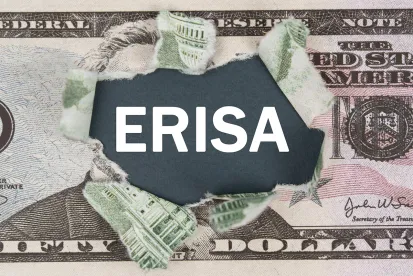Under the Employee Retirement Income Security Act (ERISA), as amended by the Multiemployer Pension Plan Amendments Act (MPPAA), a company incurs withdrawal liability when it withdraws from a multiemployer pension plan. This liability must be calculated using an interest rate that is based on the anticipated future rate of return on the fund’s investment asset portfolio, the U.S. Court of Appeals for the District of Columbia Circuit has held. United Mine Workers of America 1974 Pension Plan v. Energy West Mining Co., No. 20-7054 (July 8, 2022).
The D.C. Circuit joins the U.S. Court of Appeals for the Sixth Circuit in arriving at this conclusion.
Withdrawal Liability Calculation and Critical Interest Rate Assumption
Withdrawal liability is a statutory obligation imposed by Title IV of ERISA. This obligation is triggered when an employer’s collectively bargained obligation to contribute to a multiemployer pension plan (MEPP) ceases in whole or in part (e.g., when the employer completely or partially withdraws). The resulting withdrawal liability represents the withdrawn employer’s allocable share of the MEPP’s unfunded vested benefits (UVBs). Since UVBs represent a MEPP’s obligations to make payments beginning at some future date (e.g., when a participant retires), liabilities must be discounted back to present value (using an interest rate determined by the fund actuary) to calculate withdrawal liability.
Although several actuarial assumptions are involved (e.g., how long employees will work and how long retirees and beneficiaries will live), the interest rate assumption (Withdrawal Liability Interest Rate) is the most critical; the D.C. Circuit described it as “the weightiest assumption in the overall withdrawal liability calculation.” A lower Withdrawal Liability Interest Rate generates more withdrawal liability, which favors the MEPP and the employers not withdrawing from the plan.
Unrelated to the withdrawal liability calculation, the MEPP actuary also must select an interest rate (Funding Interest Rate) for measuring compliance with statutory minimum funding requirements. A higher Funding Interest Rate makes it easier for a MEPP to satisfy these requirements. Thus, while a low Withdrawal Liability Interest Rate generally favors the MEPPs when calculating withdrawal liability payments, a higher Funding Interest Rate is preferable for clearing statutory minimum funding requirements. Energy West arose in the context of these competing considerations.
Case Background
The facts are unremarkable. The company completely withdrew from the United Mine Workers of America 1974 Pension Plan (Fund) in 2015. In calculating the resulting withdrawal liability, the Fund actuary used interest rates published periodically by the Pension Benefit Guaranty Corporation (PBGC), a federal agency with regulatory and enforcement authority over the withdrawal liability provisions of ERISA. These “PBGC Rates” (described by the court as “risk-free”) are intended to approximate annuity purchase rates and must be used by MEPPs that terminate through a mass withdrawal.
At the time of withdrawal, the applicable PBGC Rate was 2.71%, and the Funding Interest Rate was 7.5%. The impact of using the lower rate was dramatic. The employer’s withdrawal liability calculated using the PBGC Rates was over $115 million. By contrast, the liability calculated using the rate based on historical investment performance (e.g., the Funding Interest Rate) would have been “about $40 million.” The Fund used the lower rate, which produced the substantially higher withdrawal liability.
The company challenged the Fund’s $115 million withdrawal liability assessment under MPPAA’s mandatory arbitration regime. Both the arbitrator and the district court upheld the assessment. Appeal to the D.C. Circuit followed.
D.C. Circuit Reverses
The D.C. Circuit reversed the lower court decision.
MPPAA requires that withdrawal liability be determined “using assumptions and methods which, in the aggregate, are reasonable (taking into account the experience of the plan and reasonable expectations) and which, in combination, offer the actuary’s best estimate of anticipated experience under the plan.” ERISA § 4213(a).
The Court held that the Fund actuary’s use of the risk-free PBGC Rates (which are based on hypothetical annuity purchase rates) violated the statutory command to use assumptions that are the “best estimate of anticipated experience under the plan” (Best Estimate Requirement).
As in Sofco (the Sixth Circuit case), the actuary’s testimony was central to the Court’s decision. Here, the actuary testified that, while he used the plan’s asset mix and prior experience as a guidepost for developing the Funding Interest Rate, “he did not consider the Pension Plan’s historic investment performance to inform” the Withdrawal Liability Interest Rate. To the contrary, he used the risk-free PBGC Rates, which the actuary described as assuming that the Fund would “buy an annuity to settle up the employer’s share” of the liability.
The employer (as it had done before the arbitrator and the district court) argued that the actuary’s use of the PBGC Rates violated the Best Estimate Requirement because the statute mandates using assumptions based on the anticipated future experience using the plan’s particular characteristics (such as their asset mix and the expected rate of return on such assets).
The D.C. Circuit agreed, holding that “using the plan’s particular characteristics means the actuary must estimate how much interest the plan’s assets will earn based on their anticipated rate of return.” Using PBGC Rates, the Court explained, is akin to basing the “discount rate on investments that the plan is not required to and might never buy, based on a set formula that is not tailored to the unique characteristics of the plan” (quoting the Sixth Circuit’s opinion). The Court concluded that the Withdrawal Liability Interest Rate must be “based on the plan’s actual investments” and “cannot be divorced from the plan’s anticipated investment returns.”
The Court then disposed of the Fund’s principal argument: that the withdrawal liability calculation is a settlement, and the use of PBGC Rates was therefore authorized by the Actuarial Standards of Practice (ASOP) 27. (Section 3.9(b) of ASOP 27 permits the use of a discount rate “implicit in annuity prices” when measuring the present value of benefits “on a settlement basis.”) The Court had little trouble holding that MPPAA overrides the provision in ASOP 27 permitting the use of annuity rates for calculations done on a settlement basis. Indeed, MPPAA is the law, the Court pointed out, and ASOP 27 instructs the actuary to “comply with applicable law” in the event of a conflict between standard actuarial practices and “statutes, regulations and other legally binding authority.”
After finding the use of the PBGC rates unlawful, the Court remanded the case to the district court so that the arbitrator’s award in favor of the Fund could be vacated.
The Court did not hold that the Withdrawal Liability Interest Rate and the Funding Interest Rate must be identical. Although the Withdrawal Liability Interest Rate provision (ERISA § 4213(a)) and the provision governing the Funding Interest Rate (ERISA § 304(c)(3)) are estimates of the same thing (“the best estimate of anticipated experience under the plan”), the Court noted that the language is “somewhat different.” Accordingly, the Court held that the Withdrawal Liability Interest Rate “must be similar, but need not be identical, to the” Funding Interest Rate. While acknowledging that there may be a justifiable “acceptable range” of potential rates that could be used to calculate withdrawal liability (as long as the rate used is based on the plan’s actual characteristics), the Court further cautioned that this range is narrow and that the Withdrawal Liability Interest Rate and the Funding Interest Rate will “invariably be similar.”
Next?
A third Withdrawal Liability Interest Rate appellate case is pending in the U.S. Court of Appeals for the Ninth Circuit (GCIU-Employer Retirement Fund v. MNG Enterprises, No. 21-55923). (The Ninth Circuit has jurisdiction over Alaska, Arizona, California, Hawaii, Idaho, Montana, Nevada, Oregon, and Washington.) A decision in favor of the fund in this case would create a circuit court split, when could result in the U.S. Supreme Court addressing the issue. It is also possible that the PBGC could address the issue by regulation.





 />i
/>i

